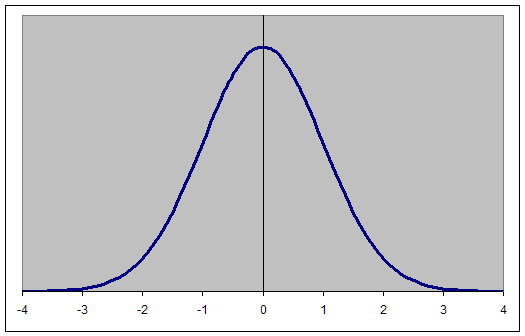The difficulty of interpreting the bible
When a person is writing a theological or philosophical work, they express their ideas using a variety of words, phrases, analogies and concepts. In a work of any significant length, ideas will be repeated more than once but expressed in different terms and ways. Each individual expression of the idea will have some relation to the idea under discussion, attempting to express or explain some truth or some part of the concept. It may be a particularly good and helpful explanation (as far as the reader is concerned) or it may do more harm than good to that particular reader's attempt to understand the concept.
 We could use a Normal Distribution to graphically depict these attempts at expressing and conveying a thought. The center of the distribution depicts the truth itself that is being attempted to be conveyed, and the datapoints are the various repeated attempts at stating and conveying that truth. Thus, many are pretty close to spot on. Most expressions and attempted explanations are somewhat close. But there are always a few outliers, which correspond to ways of expressing the idea that are not so close to the idea itself.
We could use a Normal Distribution to graphically depict these attempts at expressing and conveying a thought. The center of the distribution depicts the truth itself that is being attempted to be conveyed, and the datapoints are the various repeated attempts at stating and conveying that truth. Thus, many are pretty close to spot on. Most expressions and attempted explanations are somewhat close. But there are always a few outliers, which correspond to ways of expressing the idea that are not so close to the idea itself.This has some serious implications for practical attempts to understand a difficult piece of writing:
1. The overall gist of the content is a much better guide to accurately comprehending the author's intent than taking a small part of the work in isolation.
2. Once you have got the correct interpretation there will still be outliers. Tiny and disparate pieces of the work will exist where you do not understand what the author was trying to say, or which might seem to contradict other ideas.
3. The outliers will fit better with a theory of explanation specifically designed to explain the outliers than with a correct understanding of author intent.
To illustrate point 3 with a more detailed example: In the graph above the thesis that the author was proposing is represented by zero. Imagine you read that work and accurately conclude that the author is attempting to communicate that concept. Someone else interprets the work and mistakenly concludes the author is trying to communicate a thesis that would be represented on the graph as -3. In defense of their claim, they cite a number of passages from the author's work in support of their thesis, quoting passages that on the graph would fall in the -2 to -4 range. The graph shows how every one of these passages would agree more with the -3 interpretation than the zero interpretation. What this illustrates is that when comparing one interpretation of a work to another, the presence of some passages that agree more with the faulty interpretation than the correct one is to be expected. All suggested interpretations of a work will almost certainly be able to cite some textual support (otherwise they probably would not have been suggested), but that does not thereby indicate their accuracy.
The situation is greatly complicated by the possibility of a multi-part theory being proposed to explain the same data. If someone said "I think the author's theory is -2, 0, 2", then the entire data set would more closely cohere to their theory than it would to the zero theory, and yet they would still in fact be wrong. Occam's razor then, is quite useful in this sort of circumstance. The difficulty however, lies in accepting that once you have the correct understanding there will still be outliers and resisting the temptation to construct ad hoc theories to deal with outliers.

3 Comments:
This seems to assume a very literal approach to philosophy. This assumption is probably quite warranted when examining much modern analytic philosophy, but I don't think it holds for the more poetic philosophers such as Plato, Thoreau, Nietzsche, etc.
I think Andrew had the NT texts in mind.
Nice one Andrew. I like it.
Of course, there are various other ways you could have conveyed the same kind of concept... =)
I understood his theory as being intended to apply to all idea conveying literature. Correct me if I'm mistaken Andrew? I used the example of philosophical texts because; a) they were mentioned in the post, and b) they are what I know about.
Post a Comment
Subscribe to Post Comments [Atom]
<< Home